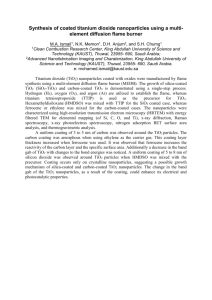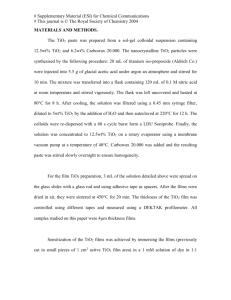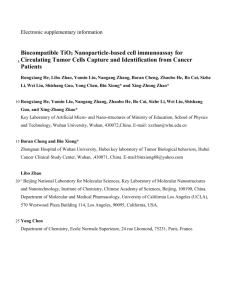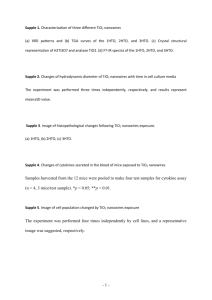Method
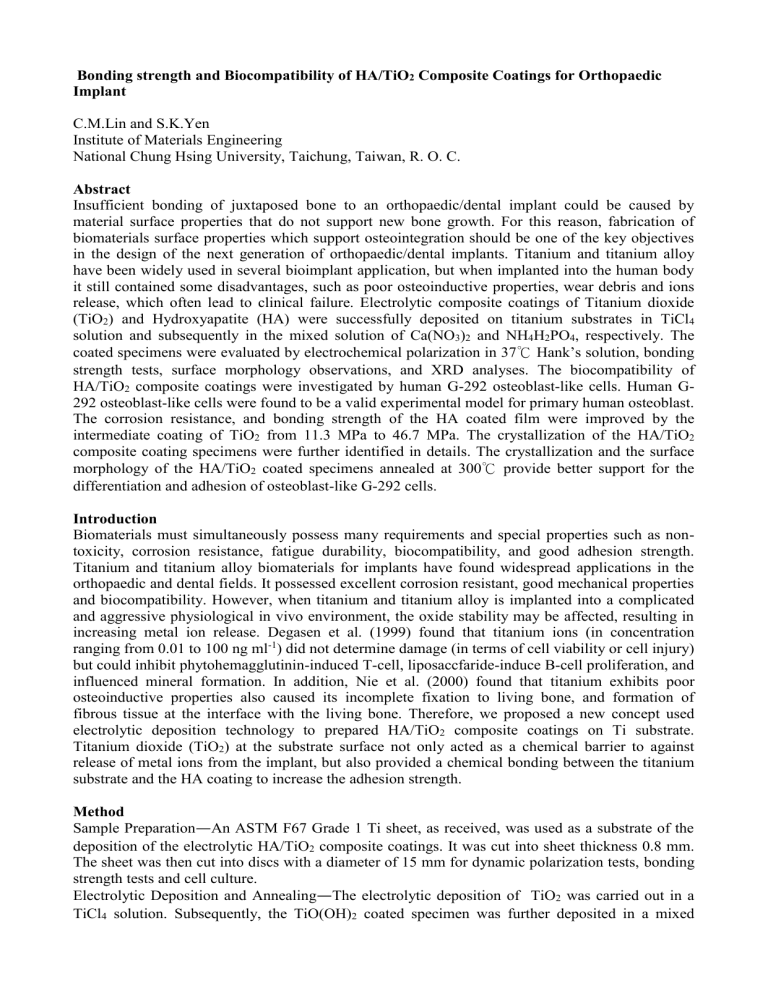
Bonding strength and Biocompatibility of HA/TiO
2
Composite Coatings for Orthopaedic
Implant
C.M.Lin and S.K.Yen
Institute of Materials Engineering
National Chung Hsing University, Taichung, Taiwan, R. O. C.
Abstract
Insufficient bonding of juxtaposed bone to an orthopaedic/dental implant could be caused by material surface properties that do not support new bone growth. For this reason, fabrication of biomaterials surface properties which support osteointegration should be one of the key objectives in the design of the next generation of orthopaedic/dental implants. Titanium and titanium alloy have been widely used in several bioimplant application, but when implanted into the human body it still contained some disadvantages, such as poor osteoinductive properties, wear debris and ions release, which often lead to clinical failure. Electrolytic composite coatings of Titanium dioxide
(TiO
2
) and Hydroxyapatite (HA) were successfully deposited on titanium substrates in TiCl
4 solution and subsequently in the mixed solution of Ca(NO
3
)
2
and NH
4
H
2
PO
4
, respectively. The coated specimens were evaluated by electrochemical polarization in 37 ℃ Hank’s solution, bonding strength tests, surface morphology observations, and XRD analyses. The biocompatibility of
HA/TiO
2
composite coatings were investigated by human G-292 osteoblast-like cells. Human G-
292 osteoblast-like cells were found to be a valid experimental model for primary human osteoblast.
The corrosion resistance, and bonding strength of the HA coated film were improved by the intermediate coating of TiO
2
from 11.3 MPa to 46.7 MPa. The crystallization of the HA/TiO
2 composite coating specimens were further identified in details. The crystallization and the surface morphology of the HA/TiO
2
coated specimens annealed at 300 ℃ provide better support for the differentiation and adhesion of osteoblast-like G-292 cells.
Introduction
Biomaterials must simultaneously possess many requirements and special properties such as nontoxicity, corrosion resistance, fatigue durability, biocompatibility, and good adhesion strength.
Titanium and titanium alloy biomaterials for implants have found widespread applications in the orthopaedic and dental fields. It possessed excellent corrosion resistant, good mechanical properties and biocompatibility. However, when titanium and titanium alloy is implanted into a complicated and aggressive physiological in vivo environment, the oxide stability may be affected, resulting in increasing metal ion release. Degasen et al. (1999) found that titanium ions (in concentration ranging from 0.01 to 100 ng ml -1 ) did not determine damage (in terms of cell viability or cell injury) but could inhibit phytohemagglutinin-induced T-cell, liposaccfaride-induce B-cell proliferation, and influenced mineral formation. In addition, Nie et al. (2000) found that titanium exhibits poor osteoinductive properties also caused its incomplete fixation to living bone, and formation of fibrous tissue at the interface with the living bone. Therefore, we proposed a new concept used electrolytic deposition technology to prepared HA/TiO
2
composite coatings on Ti substrate.
Titanium dioxide (TiO
2
) at the substrate surface not only acted as a chemical barrier to against release of metal ions from the implant, but also provided a chemical bonding between the titanium substrate and the HA coating to increase the adhesion strength.
Method
Sample Preparation — An ASTM F67 Grade 1 Ti sheet, as received, was used as a substrate of the deposition of the electrolytic HA/TiO
2
composite coatings. It was cut into sheet thickness 0.8 mm.
The sheet was then cut into discs with a diameter of 15 mm for dynamic polarization tests, bonding strength tests and cell culture.
Electrolytic Deposition and Annealing — The electrolytic deposition of TiO
2
was carried out in a
TiCl
4
solution. Subsequently, the TiO(OH)
2
coated specimen was further deposited in a mixed
solution of Ca(NO
3
)
2
‧
4H
2
O and NH
4
H
2
PO
4
with Ca/P = 1.67. The titanium disc was the cathode, platinum the anode, and saturated AgCl/Ag the reference electrode. The coated specimens were then annealed for 1 hr in air at 300 ℃ , 500 ℃ , and 700 ℃ , respectively.
Bonding strength — Bonding strength of HA/TiO
2
layer to the substrate were measured by ASTM
C-633 methods (1993). Both side of the substrate were attached to cylindrical steel clamps 15 mm in diameter and 20 mm in length by using Rapid-type Araldite glue. HA/TiO
2 coated specimens were prepared 5 samples, and the mean bonding strength were calculated from the fracture load and surface area ( π × 7.5
2
mm
2
). The fractured surfaces of the specimens were observed under a scanning electron microscope (SEM/EDS).
Dynamic polarization
—
Uncoated Ti specimen, thermal oxide film, CaP coated and HA/TiO
2 coated specimens annealed at 300
℃
were potentiodynamically polarized in aerated Hank’s solution. The cyclic polarization test ranged from – 0.80 to + 0.80 V, then back to – 0.70 V at a scanning rate of
0.167 mV/sec at 36 ± 1 ℃ . If the oxidation is due to the corrosion of the electrode, this potential is named “corrosion potential” E corr
. The current density before pitting is nearly constant and defined as the “passivation current density” i pass
.
Cell culture - Human osteoblast-like cell line G-292 (ATCC CRL 1423) , originally isolated from a human osteosarcoma. Cells were initially cultured in McCoy’5a medium containing 10
﹪ fetal bovine serum (FBS), 100 units/ml of penicillin and 100 μ g/ml of strepotmycin. The cells were then thawed and cultured in 25 cm
2 flasks and incubated at 37
℃
in a humidified atmosphere with 5
﹪
CO
2
. Media were changed every 2 days. Finally, cells were seeded onto samples (Ti substrate, CaP coated and HA / TiO
2
coated) in a 24-well plate at a density of 2
×
10
4
cells / well. The amount of cells seeded on polystyrene (PS) control (2
10
4
cells) was such as to obtain the same cell density used for the coatings.
SEM and XRD
—
The surface morphology of specimens after electrolytic deposition, polarization tests, bonding strength tests and cells culture were observed by scanning electron microscopy and the composition energy dispersive spectroscopy (SEM/EDS). The crystal structure of HA/TiO
2 composite on Ti substrate was analyzed by X-ray diffractomery (XRD).
Results
The XRD diagrams of HA/TiO
2
as-coated specimens, only found HA (major) and octacalcium phosphate (Ca
8
(HPO
4
)
2
(PO
4
) • 5H
2
O, OCP, minor). Further annealing at 300 ℃ , OCP disappeared and only HA was clearly identified on the HA/TiO
2
coated specimens. Annealing above 500 ℃ , composite coatings maintain HA crystal phase, didn’t occur phase transformation, as showed in
Fig.1. T he potentiodynamic polarization curves of the electrolytic TiO
2
coated, thermal growth oxide film, CaP coated, HA/TiO
2
composite coated and uncoated specimens in Hank’s solution at
37
℃
are plotted in Fig.2. It was found that electrolytic TiO
2
coated at the substrate surface have higher corrosion resistance than the thermal growth oxide film. Furthermore, we also observed that the corrosion potential and corrosion resistance of the HA/TiO
2
composite coating were higher, and the passivation current density and corrosion current density were lower than single CaP coated or the uncoated. Apparently, the HA/TiO
2 composite coatings exhibit the greatest corrosion resistance.
The higher E corr
, lower i corr
, lower i pass
and higher polarization resistance R p
of the HA/TiO
2
coated specimens indicate that the coated film is more resistant to corrosion or more inert than the pure Ti specimen. Fig.3 show the photographs and EDS mapping of the fractured surfaces of the CaP and
HA/TiO
2 coated specimens. In the case of the CaP coated specimen, Ca and P images were weak on whole surface of the substrate, as showed in Fig.3 (a). This indicated that the fracture occurred at the interface between the substrate and the CaP coated. CaP coated specimen tensile bonding strength only about 11.3 MPa. In the case of the HA/TiO
2
coated specimens in Fig.3 (b), Ca and P
images were strong on the whole surface of the substrate. This indicates that the fracture occurred at the HA-glue interface, leaving the HA layer on the substrate. HA/TiO
2
coated specimen tensile bonding strength increase to 46.7 MPa. In addition, osteoblast-like cells on HA/TiO
2
coated surface exhibiting the polygonal and stellate morphology. The polygonal cells extended their broad
0
10
500
1000 cytoplasmic form fine radiate-like pseudopodia it would enhance cells adhesion and future migration activity, showed in Fig.4.
O:OCP
H:HA
T:Ti
R:Rutile TiO
2
Fig.4 The surface morphology of the G-292
pure Ti
1000
800
electrolytic TiO
2
-300¢J
thermal oxide-300¢J
2
-300¢J electrolytic
HA-TiO
2
-300¢J on HA/TiO
2
coated.
2
-300¢J thermal oxide-300¢J pure Ti
CaP-300¢J
600
700¢J
500¢J
300¢J
400
200
20 30 40
2£c
50 60 as-coated
Ti
70
0
-200
-400
-600
-800
-1000
-14 -13 -12 -11 -10 -9 -8 log(I)(A/cm
2
)
-7 -6 -5 -4 -3
Fig.1 XRD diagrams of HA / TiO coated specimens as coated and annealed at 300
℃
, 500
℃
and 700
℃
, respectively.
2
composite
Fig.2 Polarization curves of the uncoated (pure
Ti), thermal growth oxide TiO
2
, electrolytic deposition TiO
2
coated, CaP coated and HA /
TiO
2
coated specimens in Hank’s solution at 37
℃ .
500 μ m
(a)
500 μ m
2 composite coated.
(b)
1
0.8
0.6
5 μ m
0.4
0.2
0
PS Ti CaP HA/TiO2
Fig.5 Alkaline phosphatase activity of the G-
292 osteoblast-like cells after 14 days grown on polystyrene (PS), pure Ti, CaP coated and HA/TiO
2
coated
Discussion
The DCPD that didn’t appear on HA/TiO
2
coated specimens was attributed to the high concentration of OH
-
supplied by the first deposition of TiO(OH)
2
. Yen et al. (2002) found that very concentrated OH
-
environment could transform HPO
4
2
into PO
4
3
. The signification result indicate that TiO(OH)
2
gel not only promoted the HA synthesis, after annealing at 300 ℃ it would provide a chemical bonding to increase bonding strength. The excellent adhesion was attributed to the condensation of TiO(OH)
2
with OH bonds adsorbed on Ti substrate and OH bonds of HA to form the very strong Ti-TiO
2
-HA chemical bonding. After 3 days incubated, the cell morphology on PS and Ti surface appeared cytoplasmic generate a more wide spread form. Furthermore, the microvilli become longer and inter-cellular links. On the contrary, osteoblast-like cells on HA / TiO
2
coated surface exhibiting the polygonal and stellate morphology. The polygonal cells extended their broad cytoplasmic form fine radiate-like pseudopodia it would enhance cell adhesion and future migration activity. After 14 days cell culture, we could observe cell differentiation on the HA/TiO
2
needle-like coated specimens had evident increasing contrast with PS and mirror-polished Ti substrate. The results indicated that roughness needle-like surfaces induced adhesion pseudopodia form a good cell adhesion. The results presented here also support that materials characteristics may play an important role, and explain why the reaction of the bio-active materials is better than that of bioinert material. Bio-active materials, such as HA/TiO
2
may promote osteogenesis and establish an interfacial bond with nearby tissues.
Conclusions
A novel electrolytic coatings method of HA/TiO
2
composite coatings has been successfully conducted on pure titanium to investigate its characteristics. Through the electrolytic deposition, annealing, dynamic polarization tests, surface observations, XRD analysis, bonding strength tests and cell culture assays, several conclusions are drawn:
1.
The previous TiO
2
coating and/or the further annealing had the effects on reducing the amount of DCPD and OCP in HA, and the crystallization of HA on the CaP and HA/TiO
2
coated specimens annealed at 300
℃
was the best. In addition to, it also stabilized the HA-coated film to avoid high temperature phase transformation (Ca
2
P
2
O
7
) and
β
-Ca
3
(PO
4
)
2
).
2.
The adhesion strength of electrolytic deposited HA on Ti substrate was dramatically improved from the 11.3 MPa to 46.7 MPa by adding the intermediate electrolytic deposition of TiO
2
, which showed the strong chemical bonding effects between Ti alloy substrate and HA coating.
3.
The polarization tests in Hank’s solution revealed that the HA/TiO
2
coated was the greatest corrosion resistant.
4.
HA/TiO
2
composite coatings served as good substrates for the adhesion and spreading of the osteoblast-like G-292 cell. From the cell activity assay, the mirror-polished surface evident more cell proliferation. This proliferation rate can qualitatively be related smooth surfaces and produce less adhesion pseudopodia, thus promoting their proliferation. In contrast to roughness needle-like HA/TiO
2
coated specimens, they induce adhesion pseudopodia form a good cell adhesion and further cell differentiation.
References
Degasne I, Basle MF, Demais V, Hure G, Lesourd M, Grolleau B, Mercier L, Chappard D. Effects of roughness, fibronectin and vitronectin on attachment, spreading, and proliferation of human osteoblast-like cells (Saos-2) on titanium surfaces, Calcified tissue international, 64:499-507, 1999
Nie X, Leyland A, Matthews A. Deposition of layered bioceramic hydroxyapatite/TiO
2
coatings on titanium alloys using a hybrid technique of micro-arc oxidation and electrophoresis, Surface coatings technology, 125:407-414, 2000
Designation: C-633. Standard test method for adhesion of cohesive strength of flame-sprayed coatings, Annual book of ASTM standards, Philadelphia, 3.01:665-669, 1993
Yen SK, Lin CM. Characterization of Electrolytic Al
2
O
3
/CaP Composite Coatings on Pure
Titanium, Journal of the Electrochemical Society, 149:79-87, 2002




